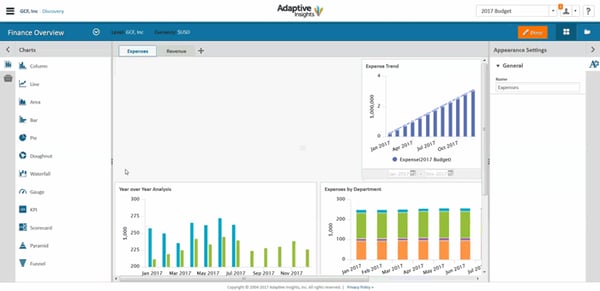As marketers in 2020, there's one major thing that we have in common: We're driven by data.

Regardless of whether we're copywriters, social media managers, videographers, or web designers, data is key to helping us determine which projects are successful, which strategies might require more of a budget, and which tactics we need to leave behind.
But those who thrive on data also know its one major downfall: it can take hours to collect and organize.
Even if you have an analytics software that tracks a campaign's traffic, engagements, ROI, and other KPIs, you'll likely still need to take time to organize these numbers, analyze them, and come up with an understandable way to report on your projects to your team or clients.
In the past, marketing firms and agencies tasked full-timers with reporting-related duties. And, although much of the data collection process has been automated by various analytics software, marketing teams and firms are still losing countless hours on manual data reporting.
This is a problem that my Cleveland-based marketing firm, PR 20/20, ran into a few years ago.
As part of our process, we create monthly performance reports for each of our clients. When we create them, we pull the data from HubSpot and Google Analytics. Then, we write a report to explain the data to our colleagues, clients, and project stakeholders.
These reports allowed our clients to make better sense of the numbers they were seeing and formulate their strategies around where they performed well or needed improvement. But, although they were helping our clients, creating them was holding our team back.
While our clients found the reports valuable, the process of pulling the data, analyzing it, and drafting the reports easily took five hours per client, per month. This took our marketers away from tasks that could have been productive in the long run, such as brainstorming new ideas and strategies that could noticeably help their clients.
In this blog post, I'll walk you through how to streamline reporting with AI, using our own experiment as an example.
How to Streamline Your Reporting Processes with AI
Step 1: Research your AI software options.
Whenever you're attempting to experiment with or implement a new strategy, you'll want to research the topic thoroughly.
For example, you'll want to recognize your budget and then look into software that fits into it.
You'll also want to determine the pros and cons of any software you consider. This will help you better familiarize yourself with the world of AI and which tools can actually help you. Because the topic of artificial intelligence comes with a lot of online hype, thorough research will also help you to distinguish which products are actually worth investing in and which are overhyped and overpriced.
Prior to deciding that we wanted to streamline our reporting strategy, we'd been researching AI through resources at our Marketing AI Institute.
The Institute is a media company that aims to make AI more approachable for marketers. Since we launched the company, we've published more than 400 articles on AI in marketing. We're also tracking 1,500+ sales and marketing AI companies with combined funding north of $6.2 billion.
After learning about how AI had already streamlined dozens of marketing-related processes, we decided to explore how automation and artificial intelligence could help us with our clients at PR 20/20.
We became obsessed with how smarter technology could increase revenue and reduce costs.
In the process, we found natural language generation (NLG) technology that wrote plain English automatically.
Essentially, NLG takes structured data -- such as information on spreadsheets -- and turns it into written or spoken language. You've encountered NLG anytime you've used Gmail's Smart Compose feature. Or, when you hear Amazon's Alexa respond to your voice queries.
Once we discovered a potentially helpful NLG software, we decided to run an experiment to see if the AI technology could partially or fully automate our performance report writing process.
2. Pick software that works best for your team.
After doing your research, you might learn the basics of how AI technology such as machine learning or NLG works.
Now, the next step is to search for software that works for your business. Here are a few things you'll need to consider:
- The cost: You'll want to consider the cost of any of the software's subscriptions or fees, as well as the cost to implement it. For example, you may need to contract or hire an engineer to prepare your data and take any steps to make sure the software works smoothly.
- Maintenance needed: While higher-priced software might be intuitive enough to require lower maintenance, others may need to be monitored and updated by someone who's very tech-savvy. Be sure to understand what you'll need to do if something isn't working properly so you don't incur any emergency costs.
- Usability: As a marketer, you won't want to rely on a full-time engineer to use AI software to run your reports. You'll want to shop for software that your less tech-savvy team members can eventually get trained on and learn. For example, a software that lets you adjust your settings or make basic adjustments in an easy to understand dashboard will be effective for multiple team members and require fewer software experts to manage.
As you pick out software, you'll also want to track down case studies, reviews, or user testimonials that describe how a company used the software to run reports or complete a similar activity. This will give you an idea of if the product you're considering has a good track record or credibility in the AI software industry.
When it comes to finding affordable AI-powered software, there are a number of service providers that similarly use NLG to draft analytics reports or generate dashboards that you can then share with your clients or stakeholders. Here are two highly-regarded examples:
Domo
Domo is a data visualization and reporting tool that integrates with major data and analytics platforms including Google Analytics. Once you connect these platforms, you can use a dashboard to set up and generate data visualizations or reports for your clients. These visualizations include pie charts, other graphs, and word clouds.
Preparing the data that Domo will report on also requires minimal maintenance. The platform offers guides on how to create datasets or spreadsheets that its algorithms will recognize as well as a drag and drop guide which asks you to upload specific information such as "Monthly Budget."
Here's a quick demo that shows Domo in action:
Adaptive Insights
This reporting software allows you to generate reports or reporting dashboards that your team and clients can edit and cross-collaborate on. Like Domo, it also includes a handful of data visualization capabilities.

Aside from data visualizations, you can also add boxes to your dashboards that show you scorecards that note whether you're hitting your goals or not, as well as filters that help you drill down on specific aspects of your project. Here's a demo explaining how small businesses such as nonprofits can benefit from the software's dashboard reporting features:
3. Prepare your data so your software can understand it.
Regardless of which product you choose, you'll likely need to prepare your data in a way that your software's robot or algorithm could easily recognize and analyze.
For example, before beginning our own experiment, we needed to prep the data by structuring it in a way that was compatible with the very basic NLG software we used.
The software required structured data in columns and rows to generate text. So, first, we had to pull HubSpot and Google Analytics data into spreadsheets.
Because doing this manually would take too much time and limit the potential time saved with automation, we used APIs and built our own algorithm using Google Apps Scripts to pull data into a Google Sheet.
Next, we standardized how each performance report would be formatted. We knew NLG software would be unlikely to handle completely custom reports well. So, we created a template for these reports that didn’t change each month.
To create a format for each report, we identified a set of 12 common questions we were trying to answer for clients each month:
- How much traffic came to your website, and how does that compare to the previous month? Last year?
- How engaged was last month’s website traffic?
- What were the top traffic-driving channels?
- Was there fluctuation in overall traffic, and if so, what caused it?
- How did the blog perform last month?
- How engaged was blog traffic?
- What were the top-performing blog posts?
- Were there any changes in blog traffic last month, and if so, what caused them?
- How many goals or new contacts were generated last month?
- What were the top converting pages?
- Where did goals or new contacts originate?
- Was there any change in total goals or lead volume, and if so, what was responsible?
4. Develop a template or set up a dashboard for your reports.
A good AI software will either allow you to create documents or even dashboards, as your reports. These assets can then be sent to your team or your clients so that they can easily look over and make sense of what all the data you've collected means.
Once we'd structured our data and developed a standard report format, we had to translate our standard report format into an NLG template.
The template was essentially a completed version of a performance report. When the NLG software runs, this report gets copied into the NLG software. Then rules are applied to the copy to programmatically update what’s written based on the structured data provided. Specifically, we assigned:
- Variables: Parts of the template that are swapped out with a data point.
- Conditional Statements: Branching if/then logic that selects the appropriate wording to
- Synonyms: To give the content some variety, synonyms can be added to vary the words or phrases used in the report. The NLG software will randomly insert one from a list of options that humans create.
Rather than the NLG software solely writing out a report, which could result in incomprehensible sentences that poorly discussed the data, we created the template so that the software would merely fill in the blanks of each report with specific data points.
The end result was a template that, when paired with a spreadsheet, automatically produces a unique report for each client. The final output could be a CSV, Word, or Google Doc file.
5. Test the software before implementing it.
Even if you're working with a credible AI software, you'll still want to test it and troubleshoot any issues that come to light. This prevents any AI-related incidents from occurring when the tool is actively being used by employees or on tight deadlines.
We ran hundreds of tests to guarantee the reports came out accurate and read well. And we eventually perfected the process to consistently produce clear, accurate automated performance reports.
If a software provider that you work with offers a trial or discount for testing out their product, leverage it. This will allow you to witness first-hand if the cost of the product outweighs its benefits, or give you time to identify if there is a more suitable product that you should be using.
6. Once implemented, measure your results.
Like in the testing phase, you'll want to monitor how well your tools are working when they are actually implemented in your office.
When you do this, here are a few things that you'll want to evaluate:
- The amount of time that the software is saving employees, or if there were any bugs, how much time the software cost.
- The amount of other productive or revenue-generating tasks your team was able to get done with the extra time you had.
- The ability of your team members to be trained and adapt to the new software and reporting processes.
As we tracked our new automated performance reports, we found that our tools took a fraction of the time to produce the same report that we took hours to create. Additionally, the level of detail in our client reports is now consistent across all accounts.
Before we implemented AI tools, the reports were only as strong as the account team’s comfort level of analyzing marketing performance reports.
Now, at midnight on the first of the month, our reporting program starts to pull in the data, communicates with the NLG system, and then automatically creates Google Docs with the fully written report.
The only manual part of the process now involves spot-checking the data for accuracy, applying some styling, and then sending.
What once took us five hours per report now takes 10 minutes. While the original process needed to be managed by multiple teammates, only one staff member is needed for spot-checking.
In this scenario, our company benefited from NLG technology because our new process allowed us to increase revenue from happy clients, improve the quality of our data reporting, and reduce costs of time and labor originally associated with reporting.
Resources for Automated Reporting
Although our team is able to access AI providers and experts for our in-office experiments, other small business marketers can also take advantage of this strategy somewhat affordably.
However, keep in mind that AI implementation can take time. For us, we needed to put time into building structured datasets, as well as our Report template so that our AI software could read our analytics and draft reports properly.
If you're interested in testing out your own AI experiments, but don't know where to start, check out the HubSpot Academy course, “Artificial Intelligence and Machine Learning in Marketing: Live from MAICON.” It will teach you how to apply AI in marketing using a holistic framework and begin conversations around piloting AI in your business.
![Sign up for HubSpot Academy's ML & AI Lesson [Free Online Course]](https://no-cache.hubspot.com/cta/default/53/92d8c234-8980-4b3a-ab83-f9638e1399a4.png)







![What's Holding AI Adoption Back in Marketing? [New Data]](https://blog.hubspot.com/hubfs/Featured%20Image%20Template%20Backgrounds_AC%20Copy-4.png)
![10 Challenges Marketers Face When Implementing AI in 2023 [New Data + Tips]](https://blog.hubspot.com/hubfs/ai%20challenges.png)
![How AI Can Improve Your Customer Experience [New Data + Tips]](https://blog.hubspot.com/hubfs/ai%20customer%20experience.png)
![The Complete Guide to AI Transparency [6 Best Practices]](https://blog.hubspot.com/hubfs/ai-transparency.webp)